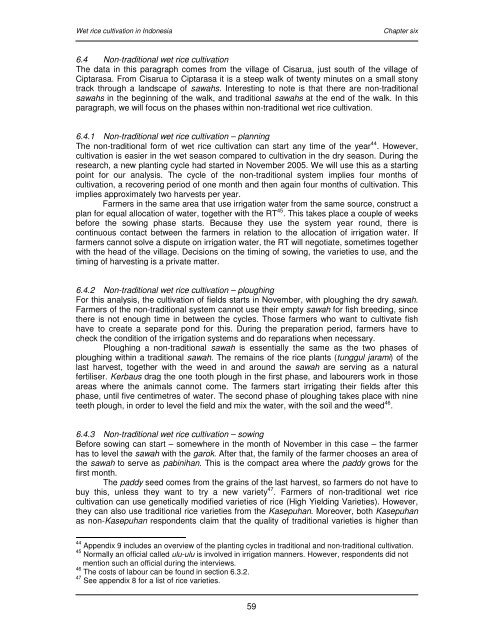Wet rice cultivation in Indonesia - Free EBooks Library
Wet rice cultivation in Indonesia - Free EBooks Library
Wet rice cultivation in Indonesia - Free EBooks Library
Create successful ePaper yourself
Turn your PDF publications into a flip-book with our unique Google optimized e-Paper software.
<strong>Wet</strong> <strong>rice</strong> <strong>cultivation</strong> <strong>in</strong> <strong>Indonesia</strong> Chapter six<br />
6.4 Non-traditional wet <strong>rice</strong> <strong>cultivation</strong><br />
The data <strong>in</strong> this paragraph comes from the village of Cisarua, just south of the village of<br />
Ciptarasa. From Cisarua to Ciptarasa it is a steep walk of twenty m<strong>in</strong>utes on a small stony<br />
track through a landscape of sawahs. Interest<strong>in</strong>g to note is that there are non-traditional<br />
sawahs <strong>in</strong> the beg<strong>in</strong>n<strong>in</strong>g of the walk, and traditional sawahs at the end of the walk. In this<br />
paragraph, we will focus on the phases with<strong>in</strong> non-traditional wet <strong>rice</strong> <strong>cultivation</strong>.<br />
6.4.1 Non-traditional wet <strong>rice</strong> <strong>cultivation</strong> – plann<strong>in</strong>g<br />
The non-traditional form of wet <strong>rice</strong> <strong>cultivation</strong> can start any time of the year 44 . However,<br />
<strong>cultivation</strong> is easier <strong>in</strong> the wet season compared to <strong>cultivation</strong> <strong>in</strong> the dry season. Dur<strong>in</strong>g the<br />
research, a new plant<strong>in</strong>g cycle had started <strong>in</strong> November 2005. We will use this as a start<strong>in</strong>g<br />
po<strong>in</strong>t for our analysis. The cycle of the non-traditional system implies four months of<br />
<strong>cultivation</strong>, a recover<strong>in</strong>g period of one month and then aga<strong>in</strong> four months of <strong>cultivation</strong>. This<br />
implies approximately two harvests per year.<br />
Farmers <strong>in</strong> the same area that use irrigation water from the same source, construct a<br />
plan for equal allocation of water, together with the RT 45 . This takes place a couple of weeks<br />
before the sow<strong>in</strong>g phase starts. Because they use the system year round, there is<br />
cont<strong>in</strong>uous contact between the farmers <strong>in</strong> relation to the allocation of irrigation water. If<br />
farmers cannot solve a dispute on irrigation water, the RT will negotiate, sometimes together<br />
with the head of the village. Decisions on the tim<strong>in</strong>g of sow<strong>in</strong>g, the varieties to use, and the<br />
tim<strong>in</strong>g of harvest<strong>in</strong>g is a private matter.<br />
6.4.2 Non-traditional wet <strong>rice</strong> <strong>cultivation</strong> – plough<strong>in</strong>g<br />
For this analysis, the <strong>cultivation</strong> of fields starts <strong>in</strong> November, with plough<strong>in</strong>g the dry sawah.<br />
Farmers of the non-traditional system cannot use their empty sawah for fish breed<strong>in</strong>g, s<strong>in</strong>ce<br />
there is not enough time <strong>in</strong> between the cycles. Those farmers who want to cultivate fish<br />
have to create a separate pond for this. Dur<strong>in</strong>g the preparation period, farmers have to<br />
check the condition of the irrigation systems and do reparations when necessary.<br />
Plough<strong>in</strong>g a non-traditional sawah is essentially the same as the two phases of<br />
plough<strong>in</strong>g with<strong>in</strong> a traditional sawah. The rema<strong>in</strong>s of the <strong>rice</strong> plants (tunggul jarami) of the<br />
last harvest, together with the weed <strong>in</strong> and around the sawah are serv<strong>in</strong>g as a natural<br />
fertiliser. Kerbaus drag the one tooth plough <strong>in</strong> the first phase, and labourers work <strong>in</strong> those<br />
areas where the animals cannot come. The farmers start irrigat<strong>in</strong>g their fields after this<br />
phase, until five centimetres of water. The second phase of plough<strong>in</strong>g takes place with n<strong>in</strong>e<br />
teeth plough, <strong>in</strong> order to level the field and mix the water, with the soil and the weed 46 .<br />
6.4.3 Non-traditional wet <strong>rice</strong> <strong>cultivation</strong> – sow<strong>in</strong>g<br />
Before sow<strong>in</strong>g can start – somewhere <strong>in</strong> the month of November <strong>in</strong> this case – the farmer<br />
has to level the sawah with the garok. After that, the family of the farmer chooses an area of<br />
the sawah to serve as pab<strong>in</strong>ihan. This is the compact area where the paddy grows for the<br />
first month.<br />
The paddy seed comes from the gra<strong>in</strong>s of the last harvest, so farmers do not have to<br />
buy this, unless they want to try a new variety 47 . Farmers of non-traditional wet <strong>rice</strong><br />
<strong>cultivation</strong> can use genetically modified varieties of <strong>rice</strong> (High Yield<strong>in</strong>g Varieties). However,<br />
they can also use traditional <strong>rice</strong> varieties from the Kasepuhan. Moreover, both Kasepuhan<br />
as non-Kasepuhan respondents claim that the quality of traditional varieties is higher than<br />
44<br />
Appendix 9 <strong>in</strong>cludes an overview of the plant<strong>in</strong>g cycles <strong>in</strong> traditional and non-traditional <strong>cultivation</strong>.<br />
45<br />
Normally an official called ulu-ulu is <strong>in</strong>volved <strong>in</strong> irrigation manners. However, respondents did not<br />
mention such an official dur<strong>in</strong>g the <strong>in</strong>terviews.<br />
46<br />
The costs of labour can be found <strong>in</strong> section 6.3.2.<br />
47<br />
See appendix 8 for a list of <strong>rice</strong> varieties.<br />
59








